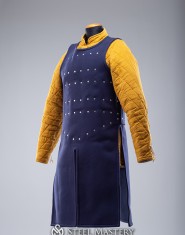Acerca de Armadura brigandina
The term “brigandine” comes from the name of foot soldiers «brigands», which actively used this plate armor. It was a kind of intermediate link between the full chain mail and the plate armor.
The time of active use of brigandine armor accounts for XIV-XV centuries. As in Europe they have not immediately returned to the Roman traditions of making cuirasses, for some time brigandine was a pretty good substitute for the armor.
Every item in this section is customized that means that you may changes color/material/metal/etc. Handcrafted medieval armor is made-to-measure, so you will get unique brigand body protection.
If you didn’t find any brigandine armour for your taste, please send us you wishes (with photos and detailed description) of armor you want to have and we will create it for you! Waiting for your requests at [email protected] :)
Brigandine armour could be divided into 4 zones:
Brigandine developed from an earlier version of so-called «coat of plates», which appeared at the end of the XII century. This armor, in fact, was the same brigandine only with larger plates. Sometimes there were two large plates, which closed the chest and a range of horizontal plates, which covered the stomach and the groin. From the external side at the top there were two rows of large rivets in a semicircle. At the bottom there were more rivets, but they were smaller.
The outer layer of brigadine is a jacket made of leather, velvet or linen. The jacket had a form of a doublet. Very often the plates were attached to a simpler linen basis, on top of which was sewn a layer of velvet or silk. The jacket usually did not have sleeves because the brigandine was usually dressed over gambeson or chain mail. Although there are images with the examples of brigandines with sleeves. Metal plates rivet on to the inner side of the jacket. Brigandines fastened from the front or on each side with leather straps. There are also references about the lacing. Surcoat with decorations and emblem can be worn over brigandine.
The design of the brigandine was quite successful. Weight was distributed in such a way that the main thrust was on the shoulders and hips. Knight's variants of brigandines were more fitted, because were individually made to order. Such brigandines consisted of many small segments. Brigandines were notable for the quality of trimming, and the representatives of all classes, even monarchs could wear them.
When in the XV century armor began to be more used by foot soldiers, it became more baggy. The size of the plates increased. Such armor was easier to pass to other foot soldier without additional fitting , in case of the death of previous owner. Manufacture and refit of brigandines were relatively simple and could be executed on-the-spot. Damaged knights suits of armor served as plates for soldier brigandines. The missing segments were actually cut of them.
The plates were attached to the jacket overlap. Fastening of plates could be both vertically and horizontally. Rivets on brigandines were put down in groups of a few pieces on one plate. Rivets on metal plates, made for the wealthy nobles, were made of brass, bronze, and could be covered with gold or silver. Sometimes they marked them coining from the outside. Some fragments of plastic images indicate the presence of large metal breastplate at the front of some brigandines. Chains were attached to this breastplate to support the sword and the shield.
The location of plates on the jacket varied. Here are a few examples of the location of plates on the brigandine that was popular in the mid-14th century.
- At the top there is a row of vertical plates covering the chest. Quantity of plates - 3. A row of horizontal plates covers an abdominal cavity, which is a little bit more in quantity - from 2 to 5. On each side there are two rows of vertical plates from 2 to 7.
- The segments that protect the abdominal cavity and the sides of a soldier, are united in one row of vertical plates.
- The armor basis of this brigandine consists of a large number (about 500) vertically arranged plates. The size of these segments is small 2-3 x 8-10 cm.
-
brigand hand armor – gauntlets and mittens made of leather and metal;
-
brigand arm armor – pauldrons, bracers and full arm defense;
-
brigand leg armor – tasses and greaves
What is interesting and attractive in brigandines of "Steel-Mastery" production?
Our main difference and advantage is in the individual making of brigandine armor. Turning to us for brigandine gauntlets, body, arms or legs protection, you can select standard models from the vast catalogue of products, or send your own, individual design or picture.
Upper part of brigandine armor (tire) is sewn only from natural materials:
- silk/jacquard
- leather
- velvet
- wool
- suede
- cotton
- linen
Metal plates for brigandine armor are made of different materials: ordinary steel or stainless steel, titanium alloy. The use of these technologies is more practical. As a result it facilitates care for armor, increases its strength. The latter is especially important for buhurt participants. Titanium brigandine armor is notable for great strength, does not rust and has twice lower weight in comparison with steel armor.
Brigandine armor rivets are made of steel or brass at the wish of customer.
If desired, brigandine can be decorated. The outer side may consist of several colored parts, or can have heraldic galloons, emblems and mottoes. Figure design of leather straps and buckles is possible. The bottom of brigandine can be decorated with festoons, the edges of which are bound with a decorative selvage.
An additional chest plate with chainholder can be set, decorated with painting or etching.
We manufacture brigandines individually for your measurements, by brigandine armor patterns. If you are not sure, how to define your size, please have a look at this table.
What is Brigandine armor? - Brigandine armor is a plates’ armor, which combines both an element of clothing and a protective element in the form of metal plates.
What is Brigandine armor made of? - Brigandine armor is made of protective elements in the form of metal plates and elements of clothing or leather.
What is Brigandine? – The term “brigandine” comes from the name of foot soldiers «brigands», which actively used this plate armor. It was a kind of intermediate link between the full chain mail and the plate armor.
Brigandine vs Cuirass. What is the difference between brigandine and cuirass? - As in Europe they have not immediately returned to the Roman traditions of making cuirasses, for some time brigandine was a pretty good substitute for the armor.
What is coat of plates? - Coat of plates is an earlier version of brigandine which appeared at the end of the XII century. This armor, in fact, was the same brigandine only with larger plates. Sometimes there were two large plates, which closed the chest and a range of horizontal plates, which covered the stomach and the groin. From the external side at the top there were two rows of large rivets in a semicircle. At the bottom there were more rivets, but they were smaller.
What is the outer layer of brigadine made of? - The outer layer of brigadine is a jacket made of leather, velvet or linen, suede, wool, cotton, silk.
How many layers are in brigandine? – There are 3 layers in brigandine:
- Outer layer
- Plates
- Basis
Brigandine with sleeves or without sleeves? - The jacket usually did not have sleeves because the brigandine was usually dressed over gambeson or chain mail. Although there are images with the examples of brigandines with sleeves. We offer removable spaulders for brigandine for extra protection.
How brigandines fasten? - Brigandines fastened from the front, from the back or on each side with leather straps. Metal plates rivet on to the inner side of the jacket.
What were brigandine metal plates rivets made of? - Rivets on metal plates, made for the wealthy nobles, were made of brass, bronze, and could be covered with gold or silver. Sometimes they marked them coining from the outside.
What location of plates on the brigandine was popular in the mid-14th century? - The location of plates on the jacket varied. Here are a few examples of the location of plates on the brigandine that was popular in the mid-14th century:
- At the top there is a row of vertical plates covering the chest. Quantity of plates - 3. A row of horizontal plates covers an abdominal cavity, which is a little bit more in quantity - from 2 to 5. On each side there are two rows of vertical plates from 2 to 7.
- The segments that protect the abdominal cavity and the sides of a soldier, are united in one row of vertical plates.
- The armor basis of this brigandine consists of a large number (about 500) vertically arranged plates. The size of these segments is small 2-3 x 8-10 cm.
How brigandine can be decorated? - The outer side may consist of several colored parts, or can have heraldic galloons, emblems and mottoes. Figure design of leather straps and buckles is possible. The bottom of brigandine can be decorated with festoons, the edges of which are bound with a decorative selvage.
What can be worn over brigandine? - Surcoat with decorations and emblem can be worn over brigandine.
Which materials are metal plates for brigandine made of? - Metal plates for brigandine armor are made of different materials with various thickness: ordinary steel or stainless steel, titanium alloy.
What types of brigandine armor patterns exist? - There are many types of brigandine armor patterns:
- Lamellar;
- Visby brigandine
- Leather brigandine
- Chinese brigandine
- Medieval brigandine
What is Visby brigandine? – Visby brigandine is Brigandine based on historical prototype which was found during the excavation of Visby battle 1361.
What types of brigandine armor exists?
- Brigandine head armor;
- Brigandine arms’ armor;
- Brigandine hands’ armor;
- Brigandine legs’ armor.
What types of brigand hand armor exist? - There are two types of brigandine hand armor, which were used in Europe in the Middle Ages:
- Different types of mittens
- Different types of gauntlets.
What is hand brigand defense made of? - Hand brigand defense is made of:
- cold-rolled steel,
- stainless steel
- titanium.
When were first historical mentions of gauntlets? - First mentions of gauntlets with plates refer to the second part of the XIII century. We could get an idea of such defense from description in the military chronicles and sepulchral figures (for example, gravestone of Robert De Blois, Norfolk, Great Britain). In the 1361 year, there was gory battle between the Swedes and the Danes. These times, brigandine armour was widely used by almost all European knights. So, it is not surprising, that large quantity of gauntlets was founded in the mass grave.
What is the design of gautlets? - Design of gauntlets represented metal plates, which were attached to the smooth base (most likely, leather base). Sample #1 has short wristband, one large plate for palm protection and narrow straps over the phalanges. Gauntlet #2 does not have a wristband (probably, it hasn’t’ been preserved). Besides, small plates of this gauntlet had being attached under the base, and big wrist and knuckle plates were attached over it. At the same time, sample #3 has long widen wristband consisted of 17 thin plates and which is fixed with two belts on the wrist. Total amount of details in this gauntlet was about hundred.
What was brigandine mitten used for? - Brigandine mitten was used for holding side-hold shield. This mitten provides good mobility and safety of fingers and the inner part of hand.
Where brigandine arm protection was widespread? –Brigandine arm protection was widespread in Europe, Asia and Вyzanthium.
Where is Brigandine arms' protection been using? - All samples of brigandine and splinted bracers, bicep protection and full arms are perfect for participation in the tournaments of medieval fencing, historical festivals, bohurts and reenactment events. Depending on the complement, such defense is compliant to the standards and rules of such social movements, as SCA (The Society for Creative Anachronism), HEMA (Historical European Martial Arts), HMB (Historical medieval battles).
What is SCA? - SCA is The Society for Creative Anachronism is an international living history group with the aim of studying and recreating mainly Medieval European cultures and their histories before the 17th century.
What is HEMA? – HEMA is Historical European Martial Arts refers to martial arts of European origin, particularly using arts formerly practiced, but having since died out or evolved into very different forms.
The first page of Codex Wallerstein - a 16th-century convolution of three 15th-century fechtbuch manuscripts, shows a fencer with various arms.
What is HMB? - HMB is a Historical medieval battles, is a rather young modern sport, full contact fighting with the use of offensive and defensive weapons characteristic of the Middle Ages.
How brigandine arm’s defense were made? - Steel plates were riveted with overlap on the leather or cloth base. Such method gave high level of protection of crushing blows, stabs and slashes. At the same time, such armour did not hinder movements of knight and weighed less than chainmail. Besides, it was rather easy to make such armour (skills of top-level armorer were not required). Every competent forger could create brigandine elements. In addition, comparing to plate armour, brigandine protection was cheaper.
When brigandine armor was used? – Brigandine armor was used in the XIII-XIV centuries. But as historical sources shows, knights were used to wear brigandine bracers and protection of upper arm even in the XII century.
What is a typical feature of brigandine armour? – A typical feature of brigandine armour was riveted plates on the outside and inner side of base. Such design was raising protection properties of armour and didn’t have any gaps for blades.
What are plate elbow caps? - Plate elbow caps are elements of brigandine arm’s defense which complemented brigandine or splinted bracers and protection of upper arm.
What is splinted protection for upper arm (bicep)? – Splinted protection is an element which protects limbs.
What was splinted protection of limbs made of? - Splinted protection of limbs was made of croupon leather with thickness 3.5-4 mm and narrow metal plates of normal steel 1.0 mm. Plates are riveted with steel rivets to the leather from the inner and outer sides of armour. There are also leather belts with steel buckles for the fixation on the arm.
What brigandine leg protection consists of? - Brigandine leg protection consists of:
- Brigandine tassets;
- Plate knee caps
- Brigandine protection for under-knee part
What were brigandine tassets made of? - Brigandine tassets were made of thick 3-4 mm leather. Metal plates were overlapped from the inside.
What are plate knee caps? - Plate knee caps are a part of brigandine leg protection.
How thigh protection and greaves were fixed? - Thigh protection and greaves were fixed from the back side of leg with leather belts. With straps, warrior attached them to the chausses or holes in the belt. Together with plate knee caps, knight had reliable protection and could fight in mounted or dismounted actions.


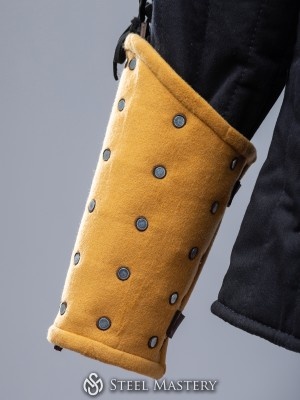


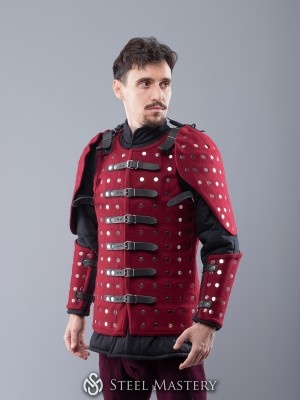
-0-3-0-1-3-300x400.jpg?v=1746523880)


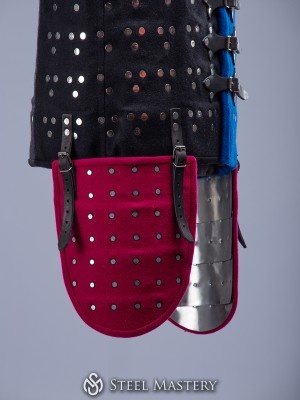


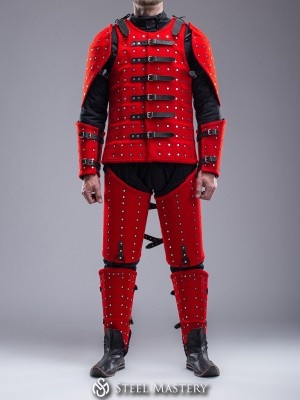
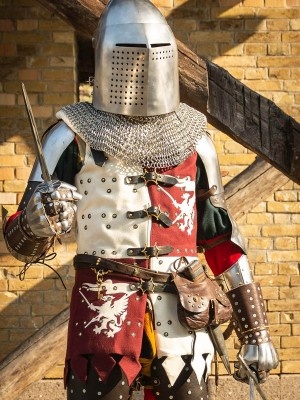
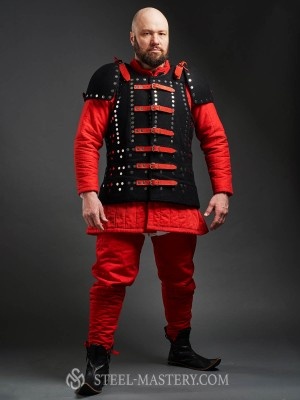
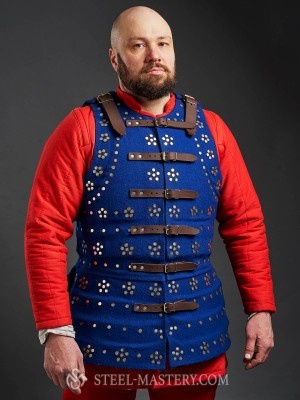
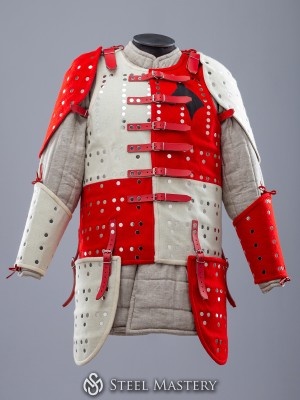
-0-3-0-1-3-300x400.jpg?v=1746523880)
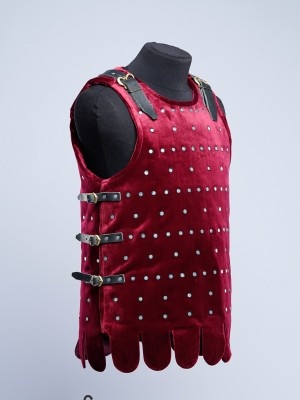
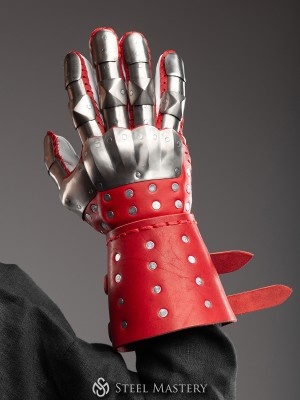
-0-3-0-1-3-300x400.jpg?v=1746523880)
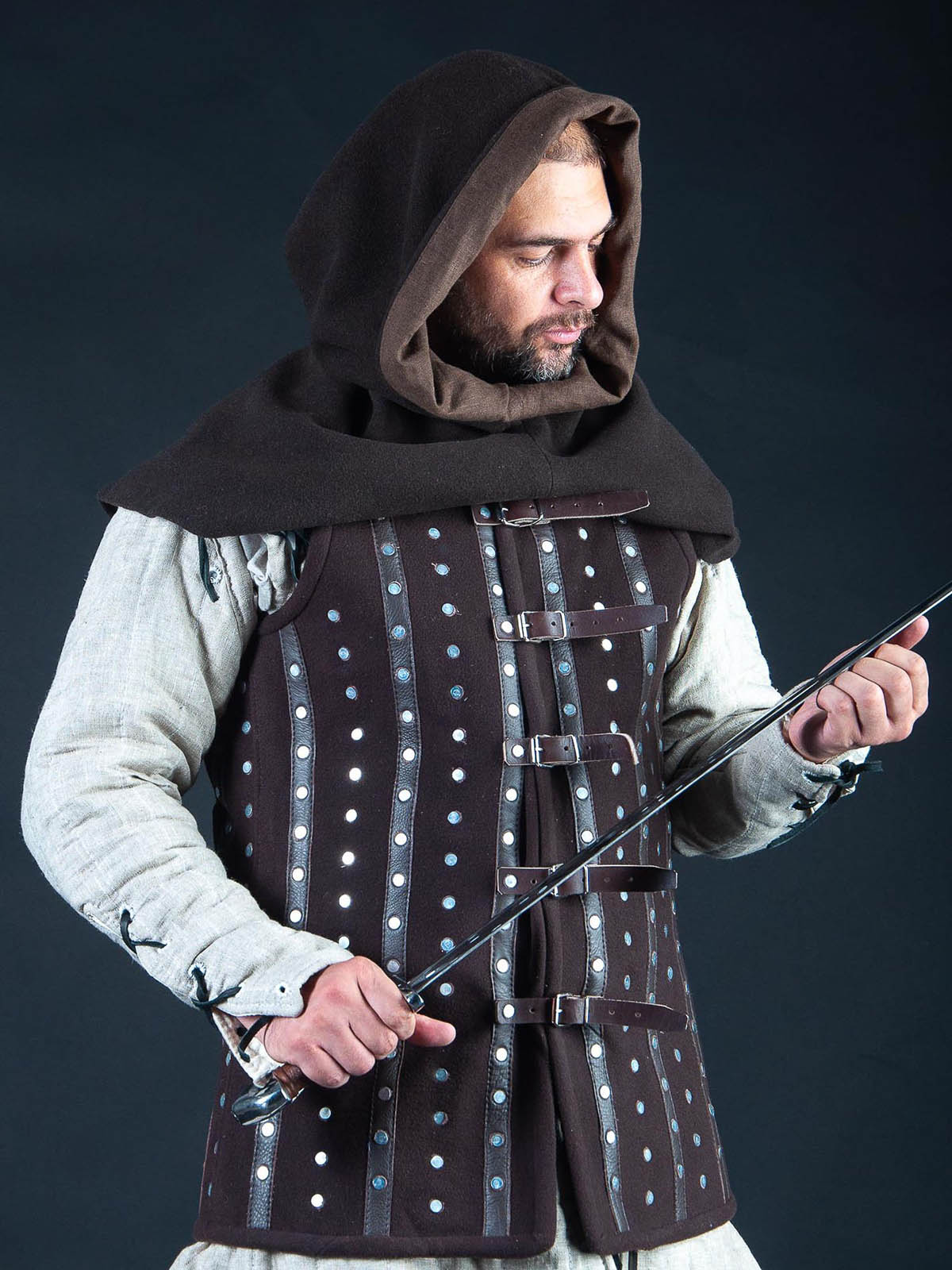
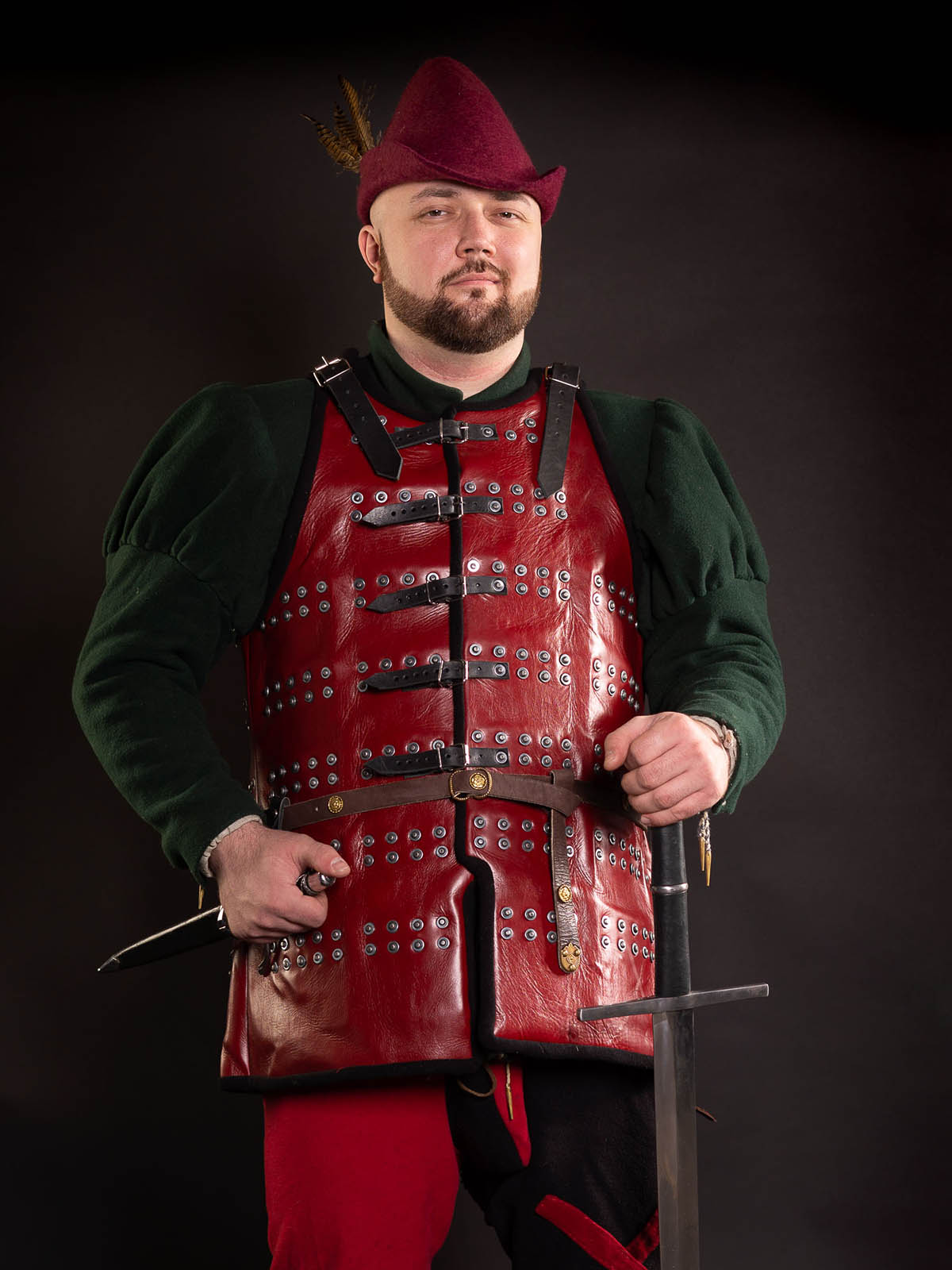
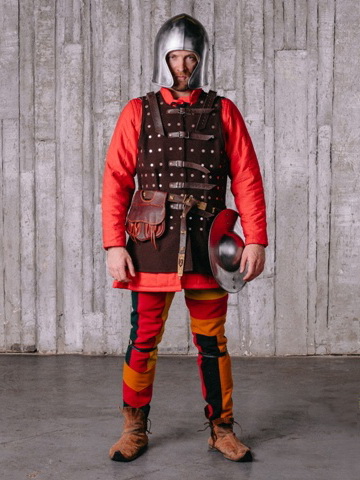
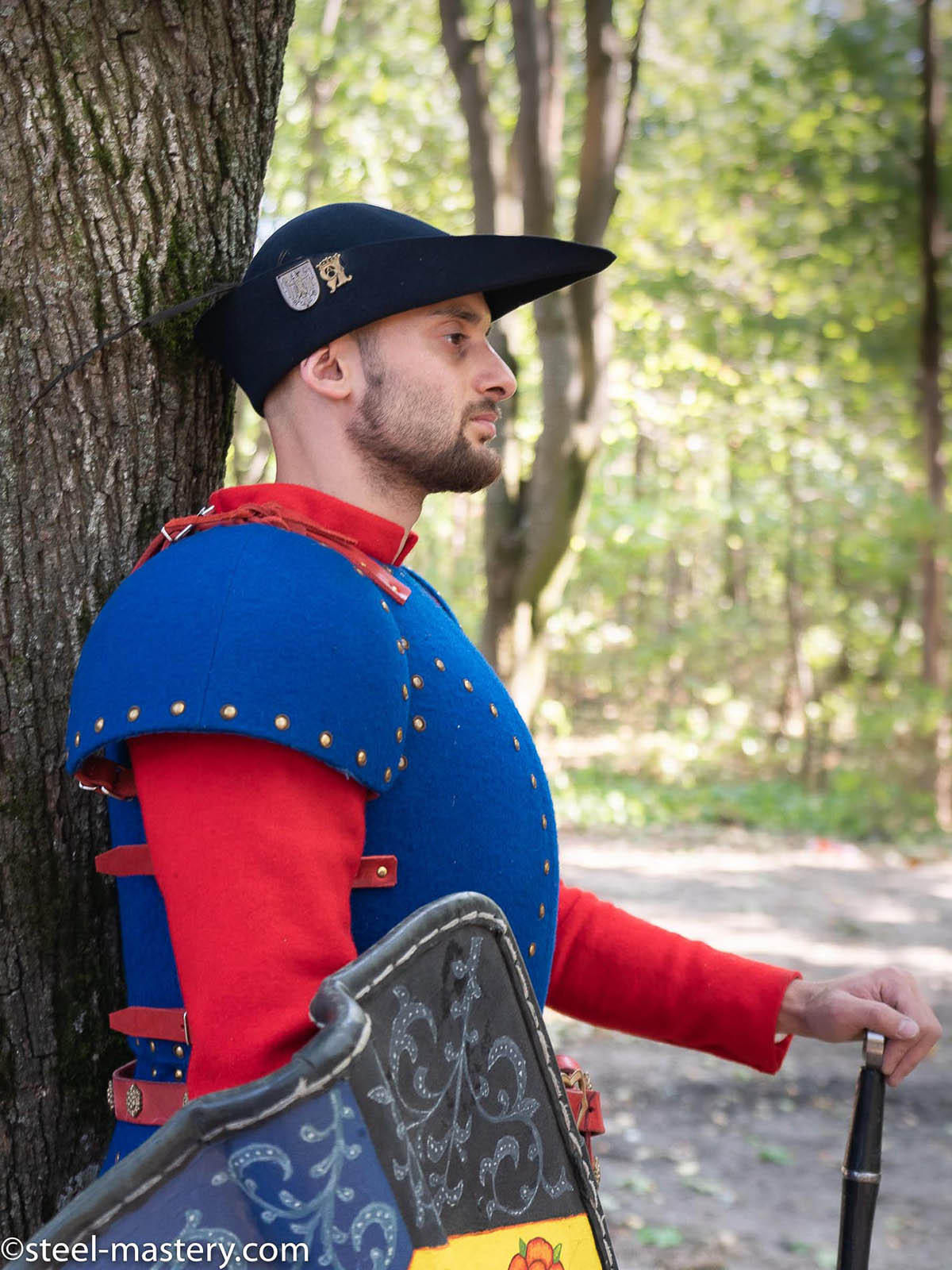
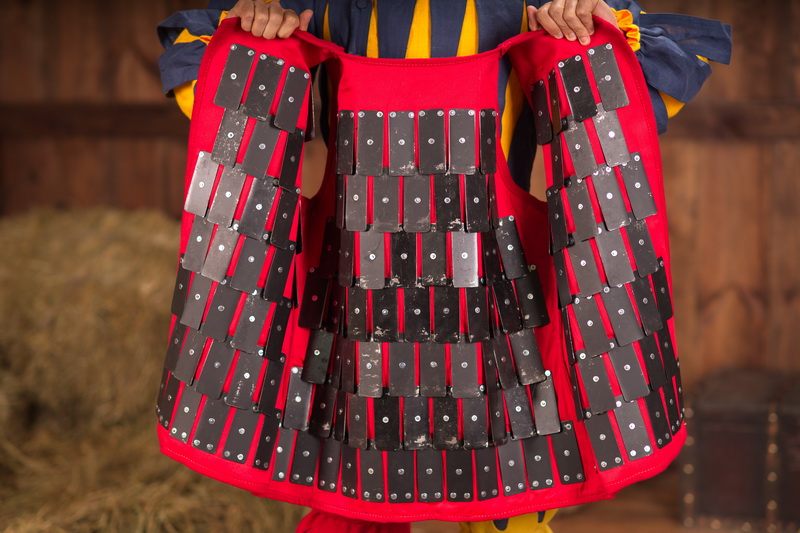
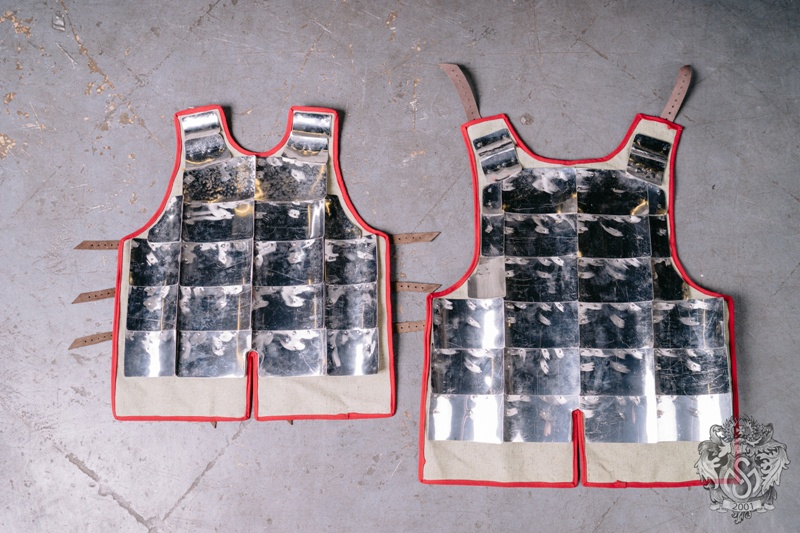
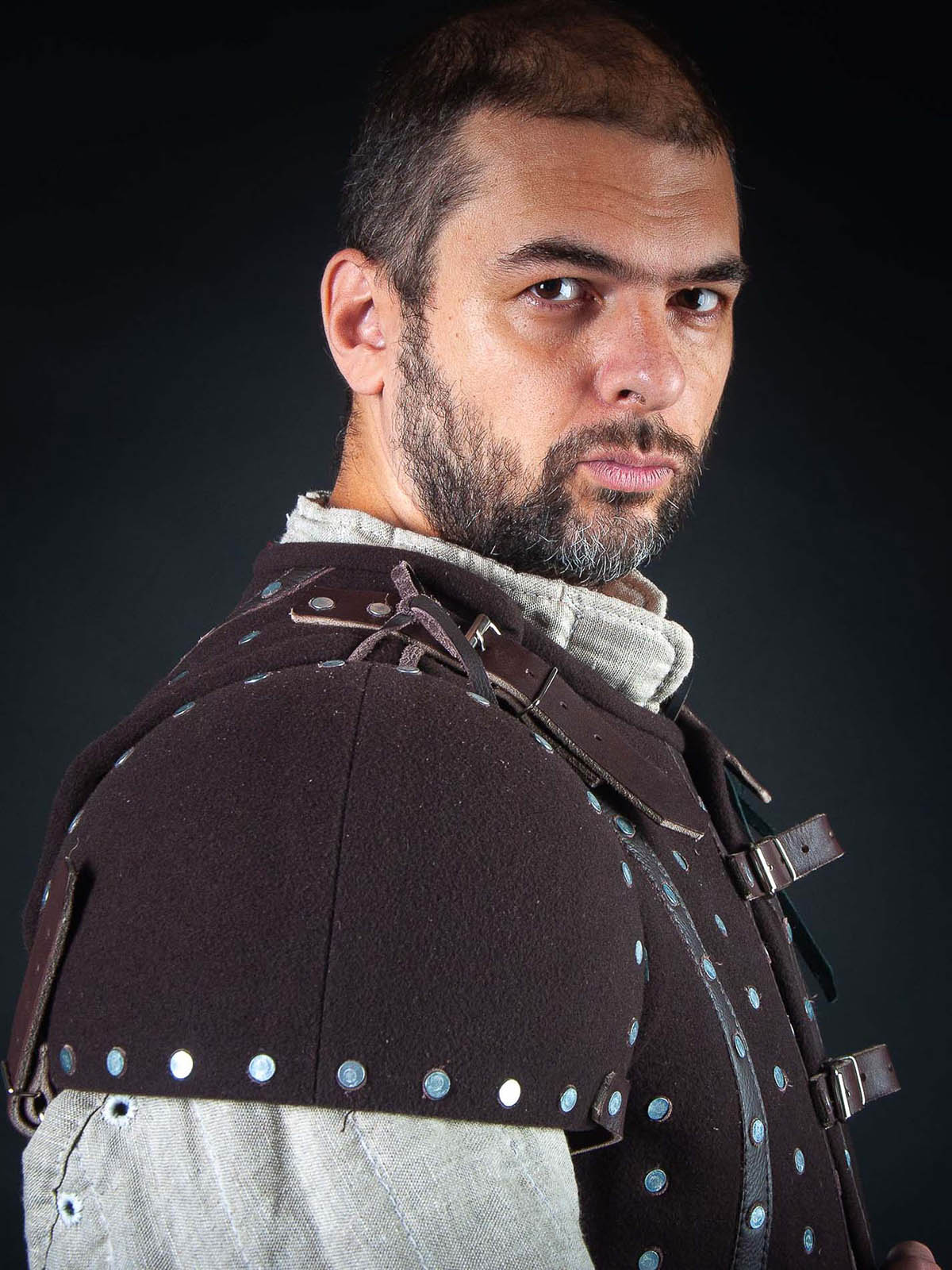
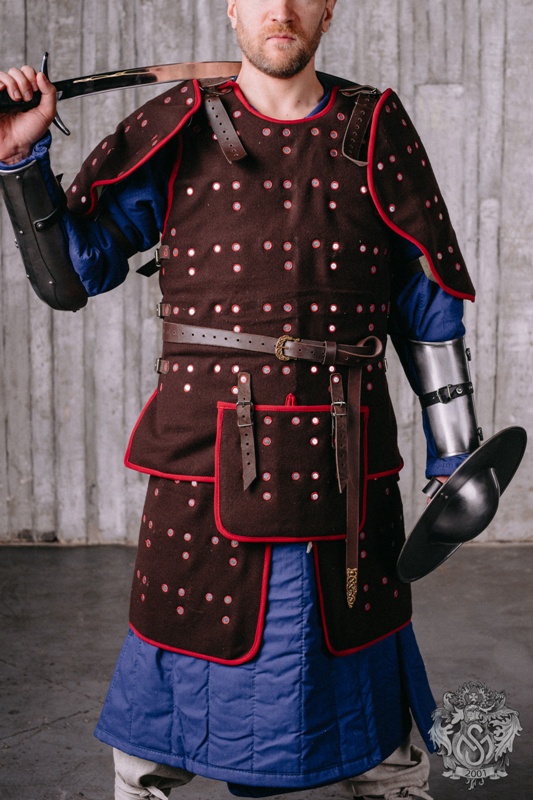
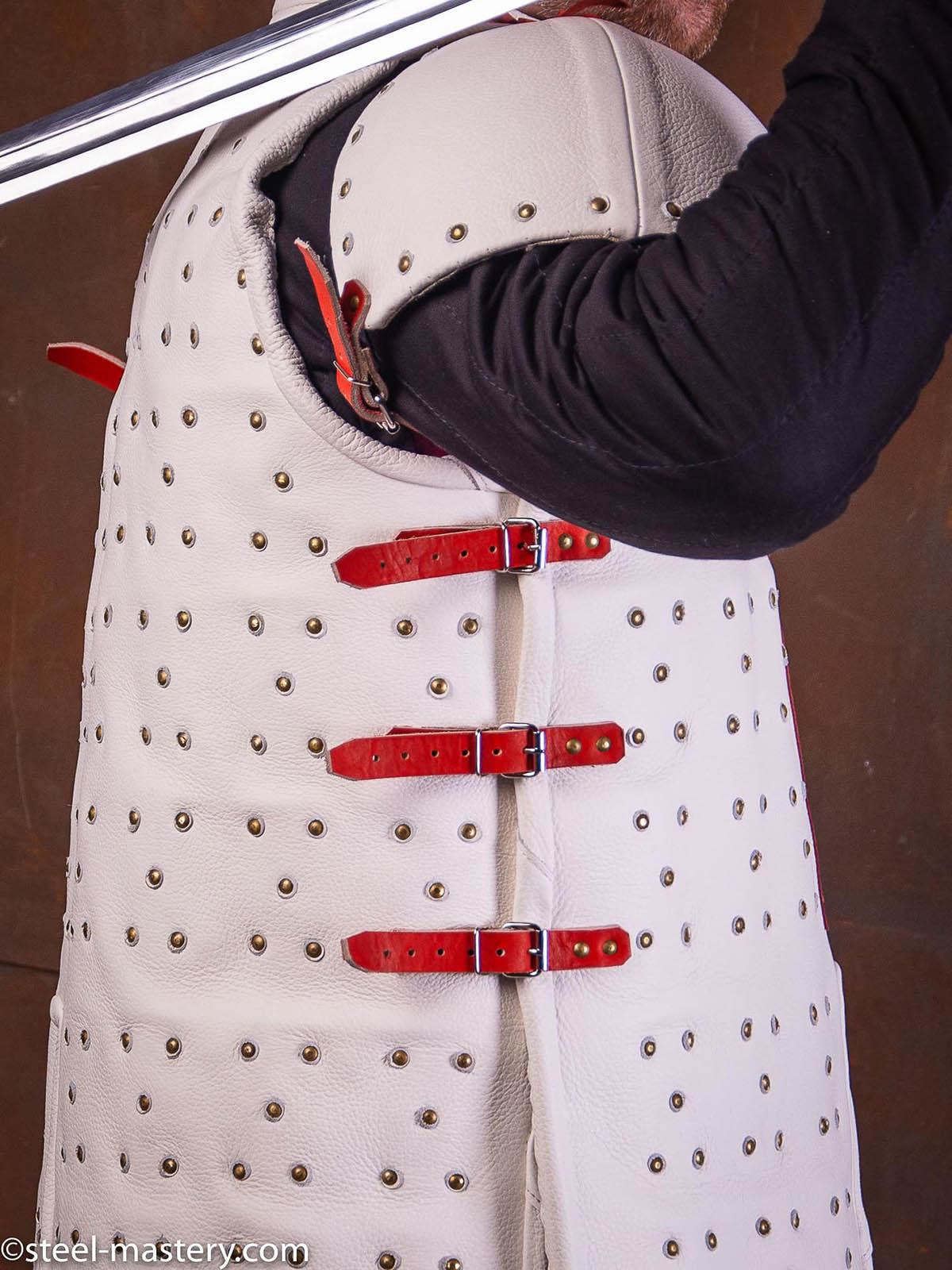
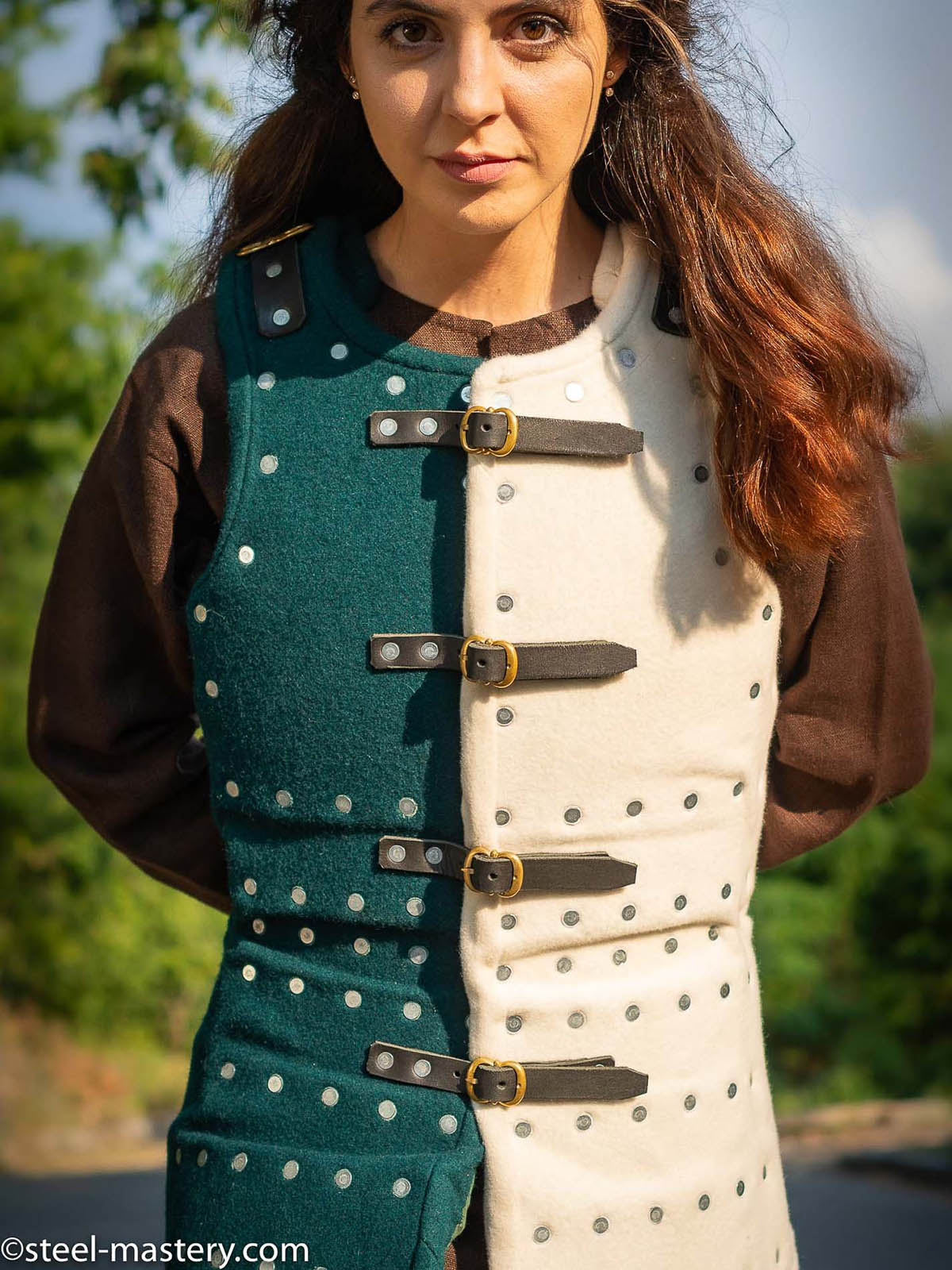
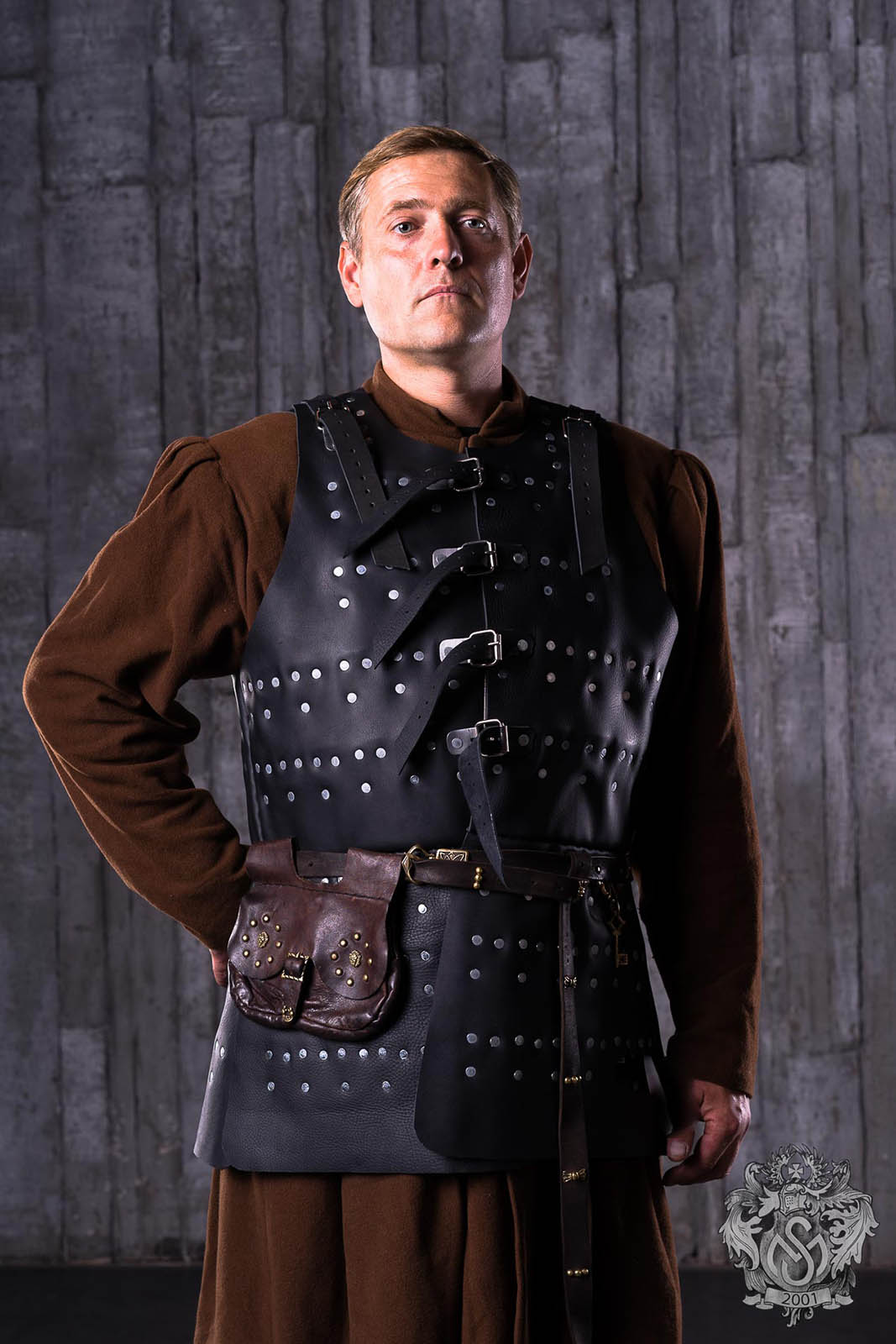
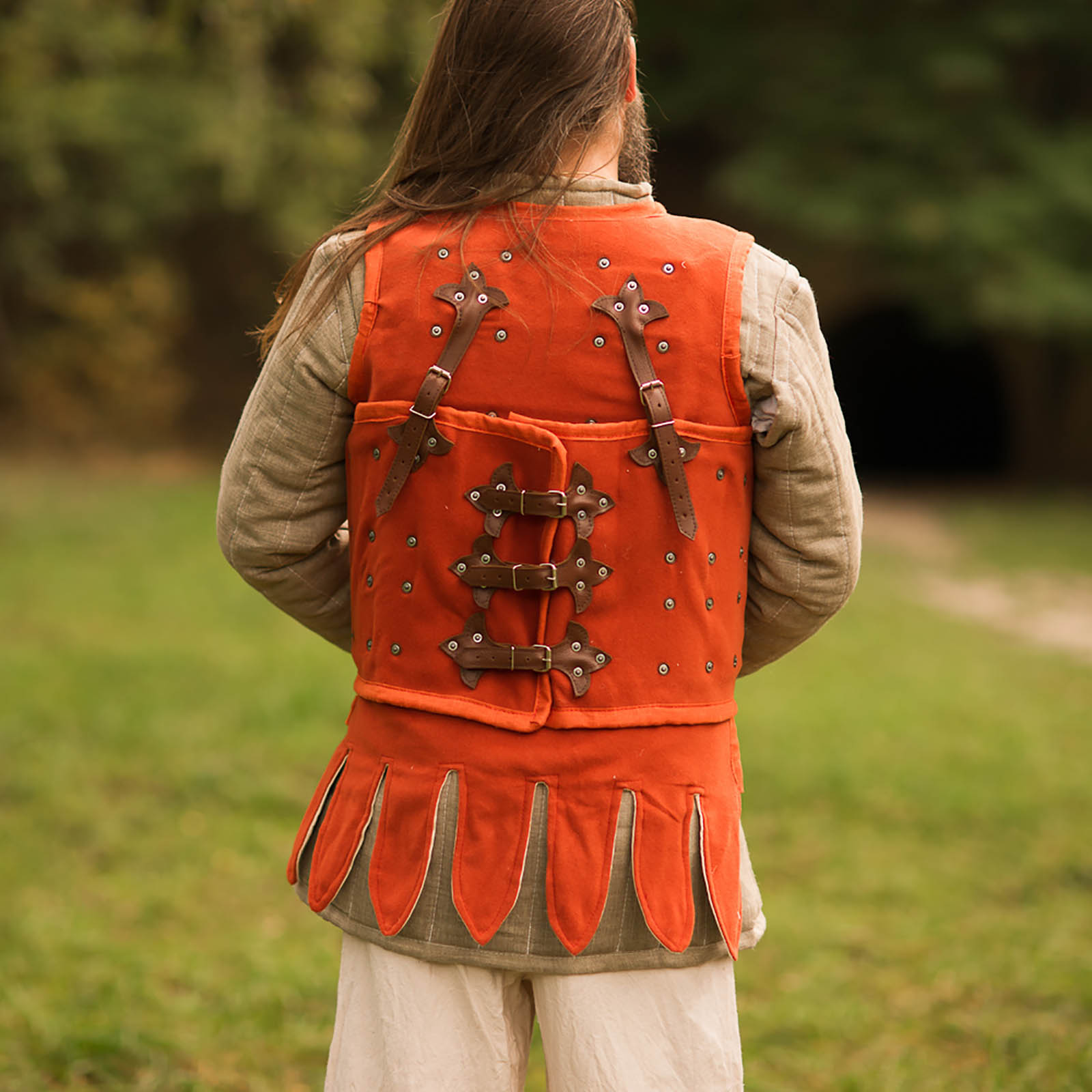
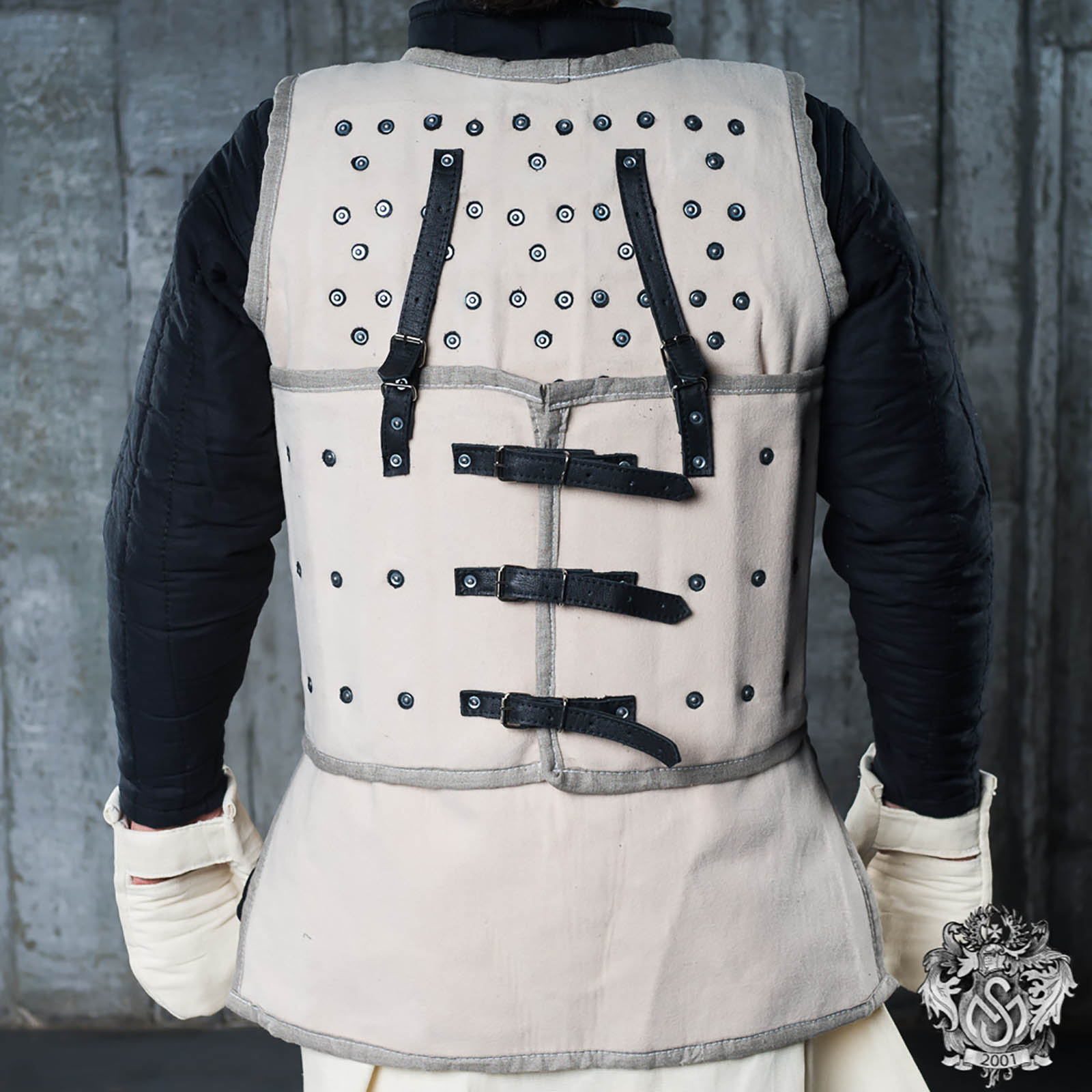
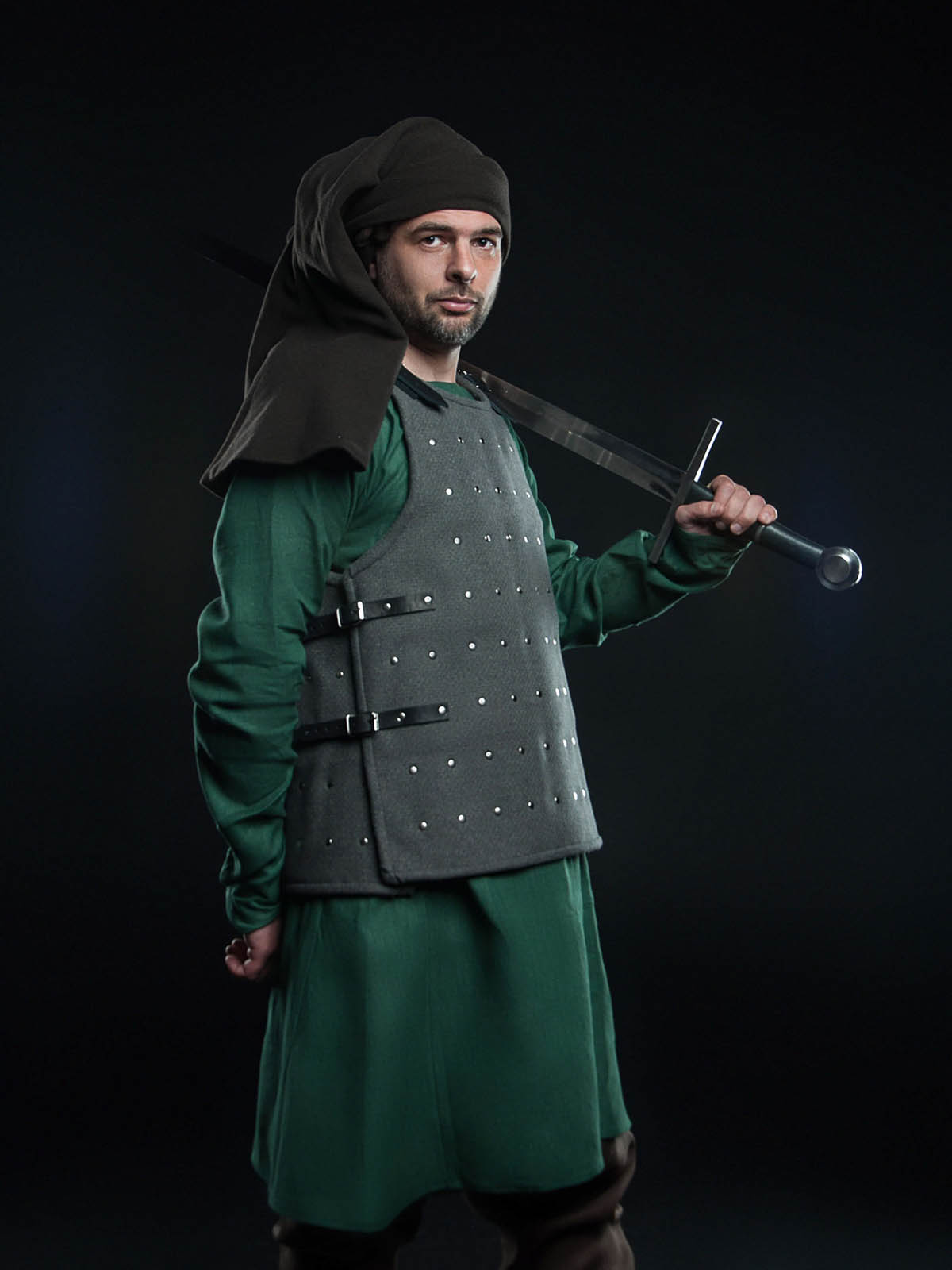
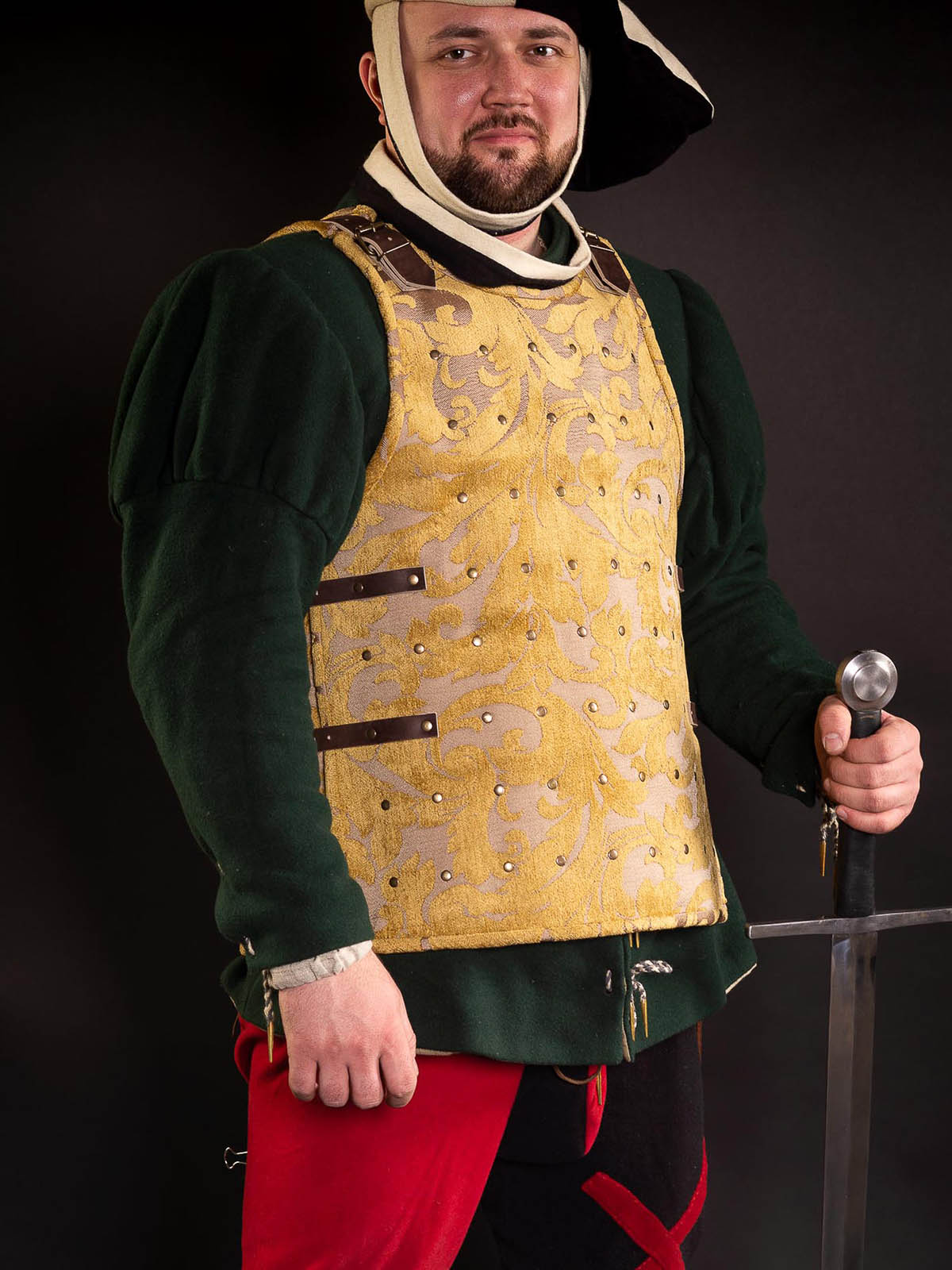
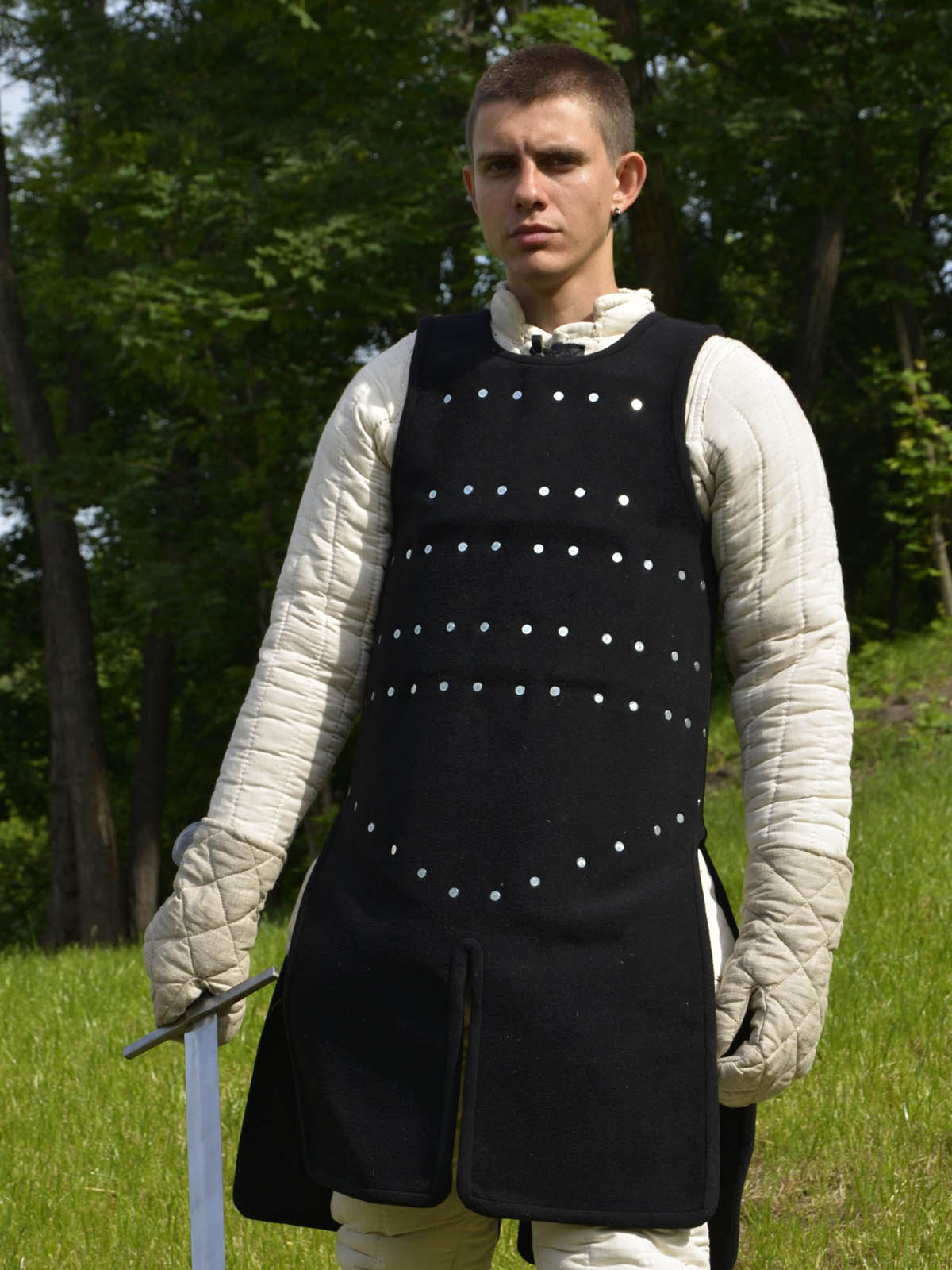
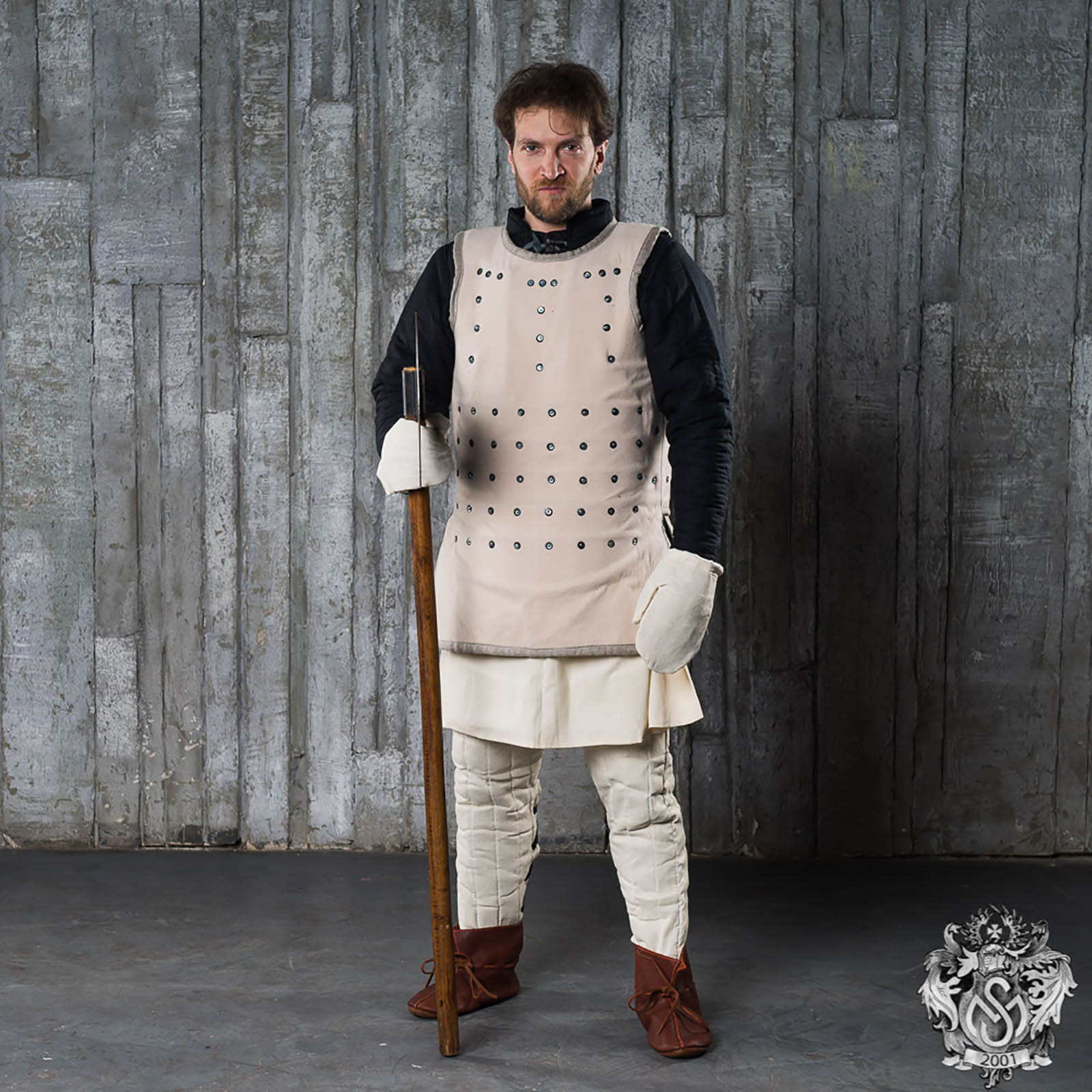
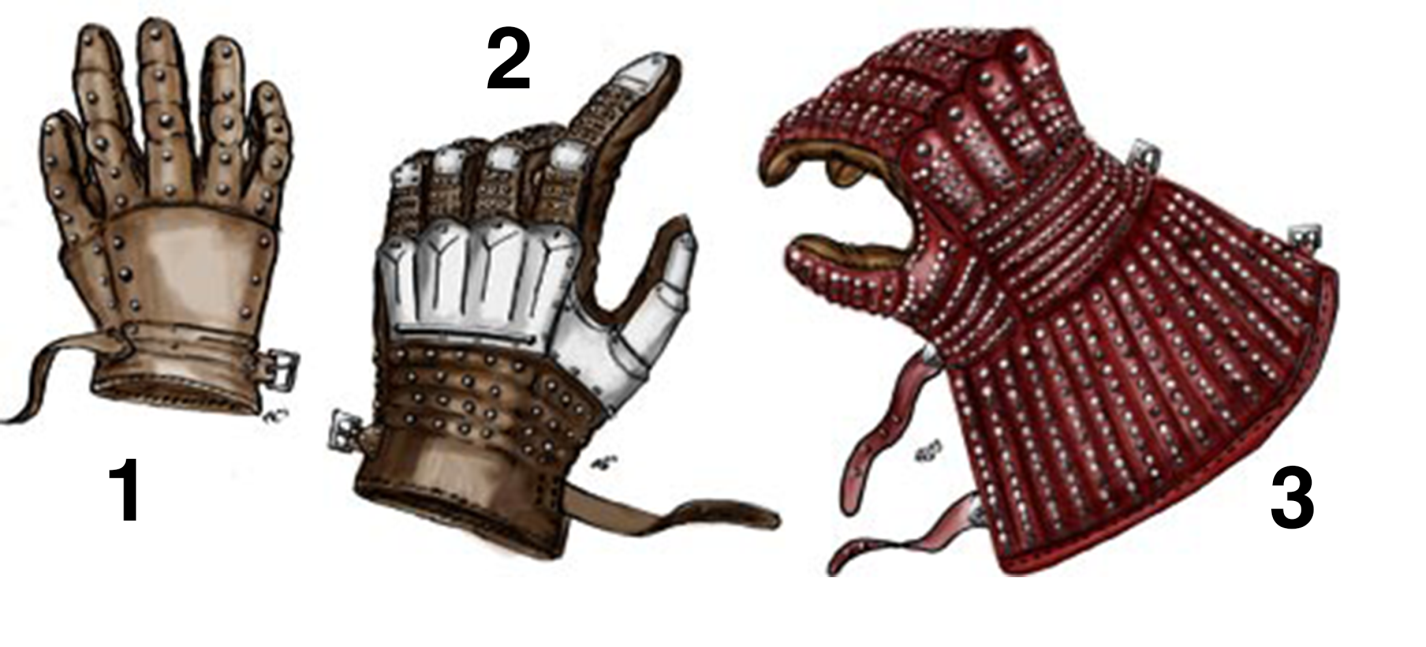
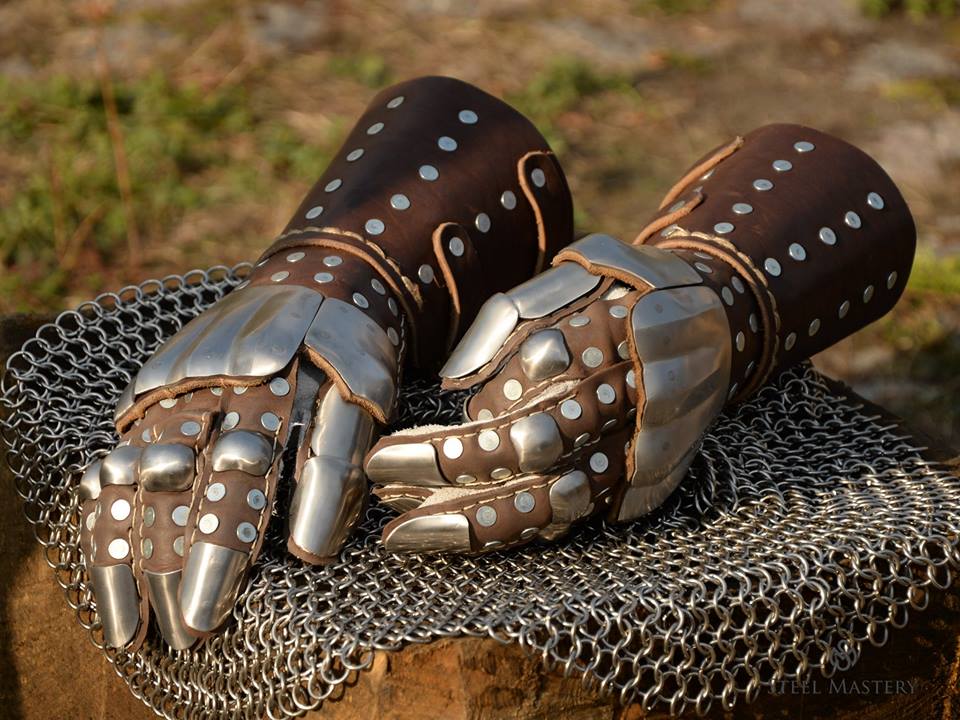
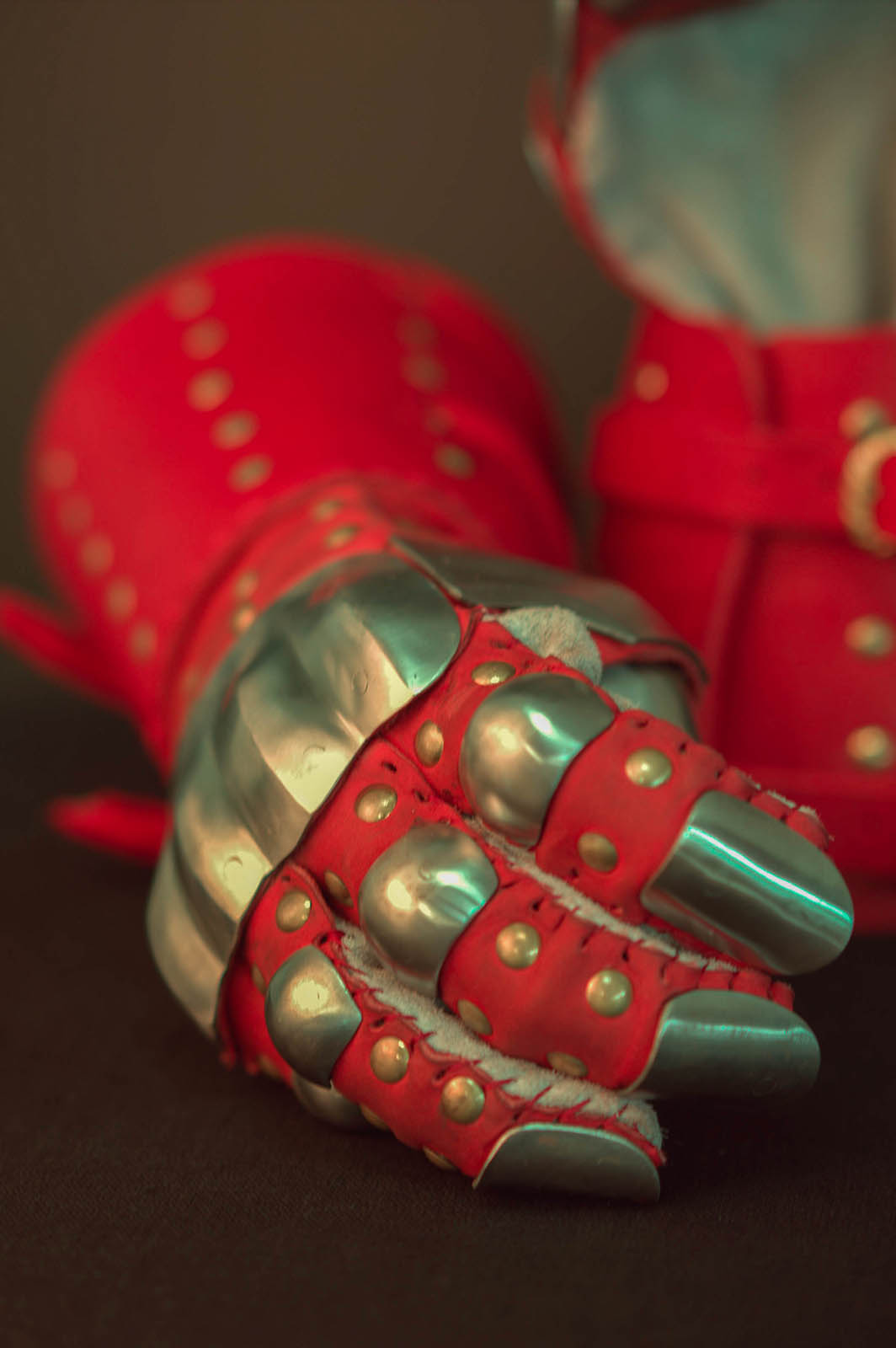
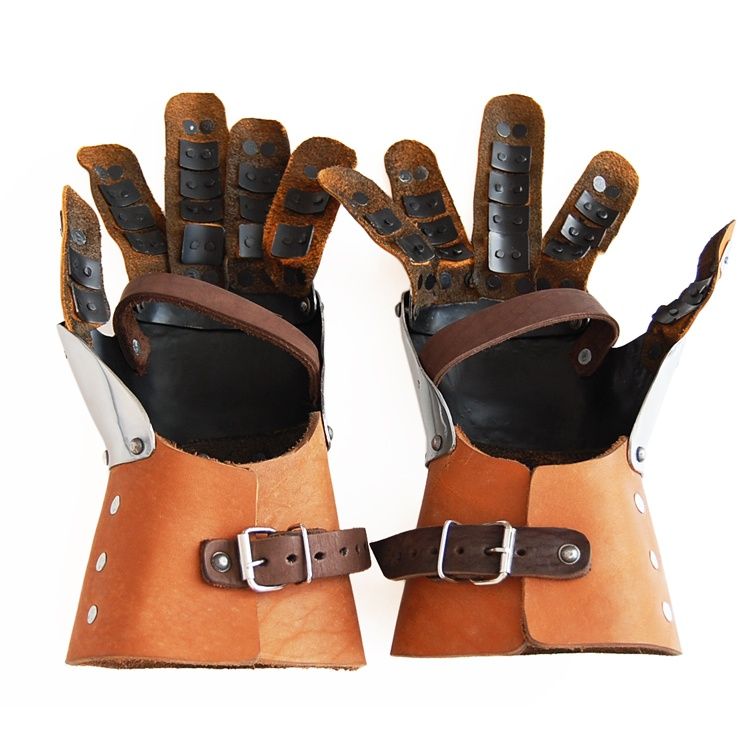
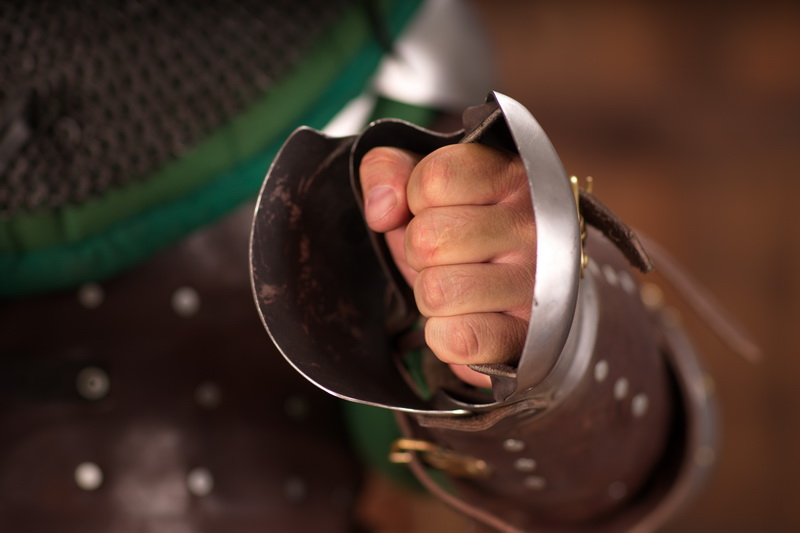
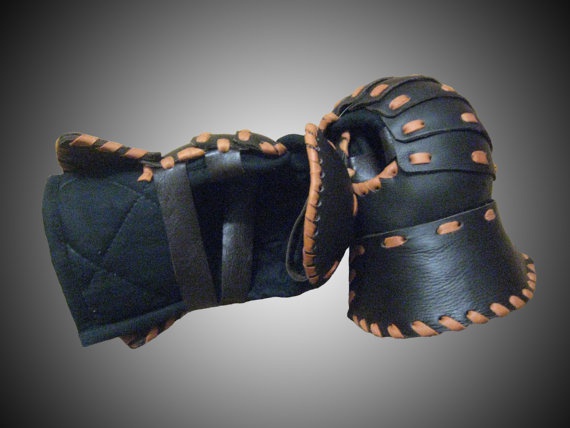
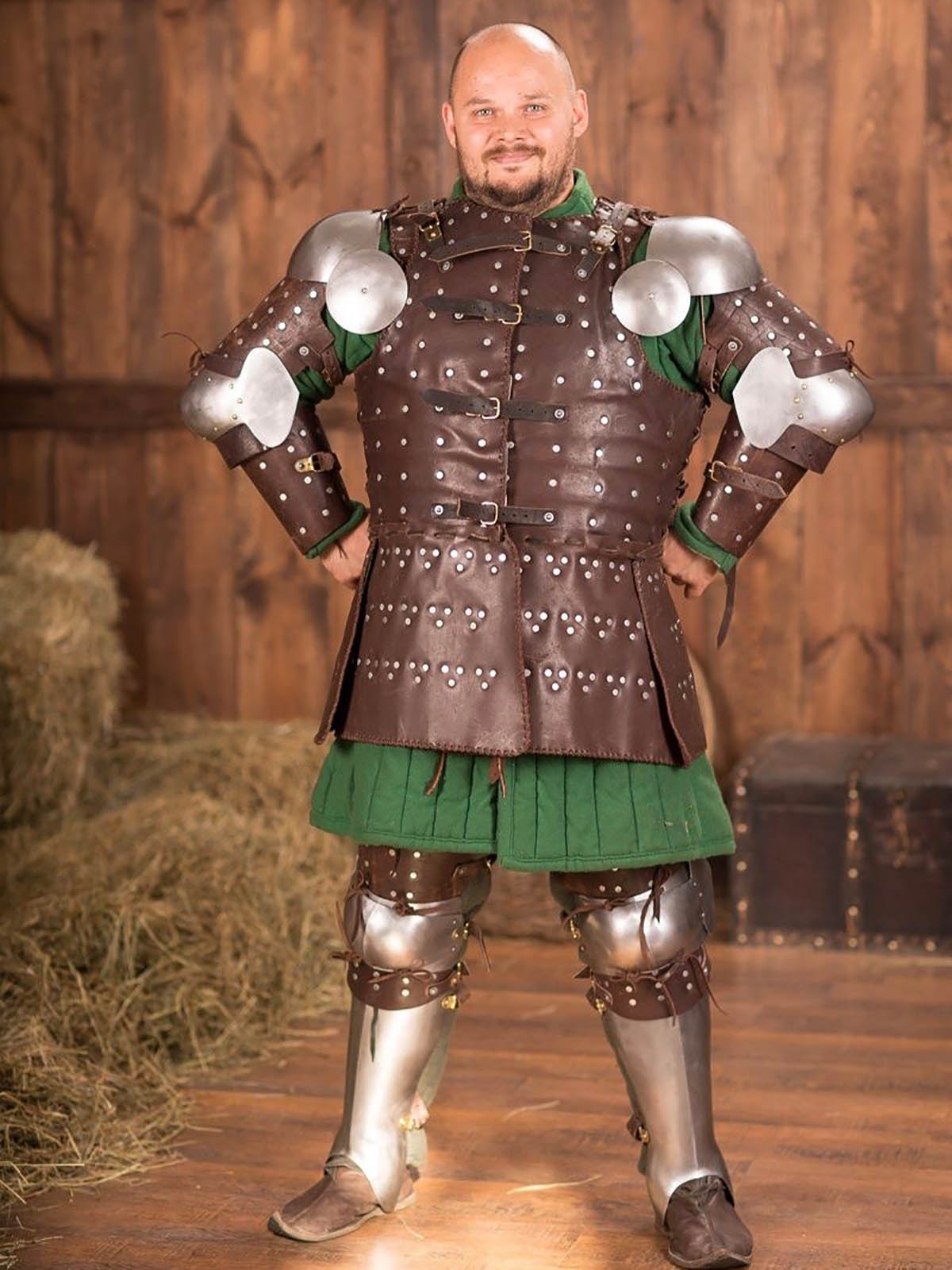
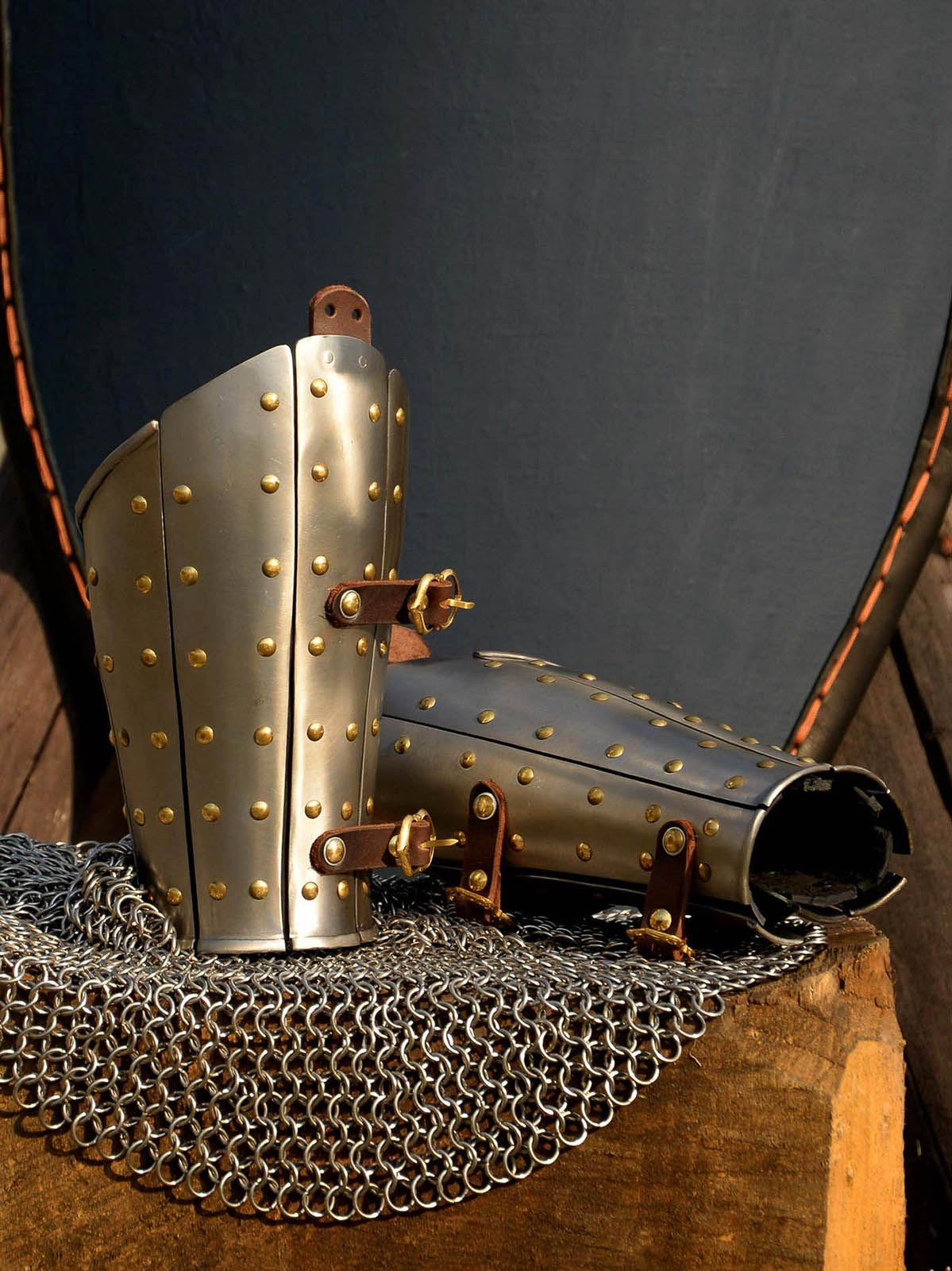
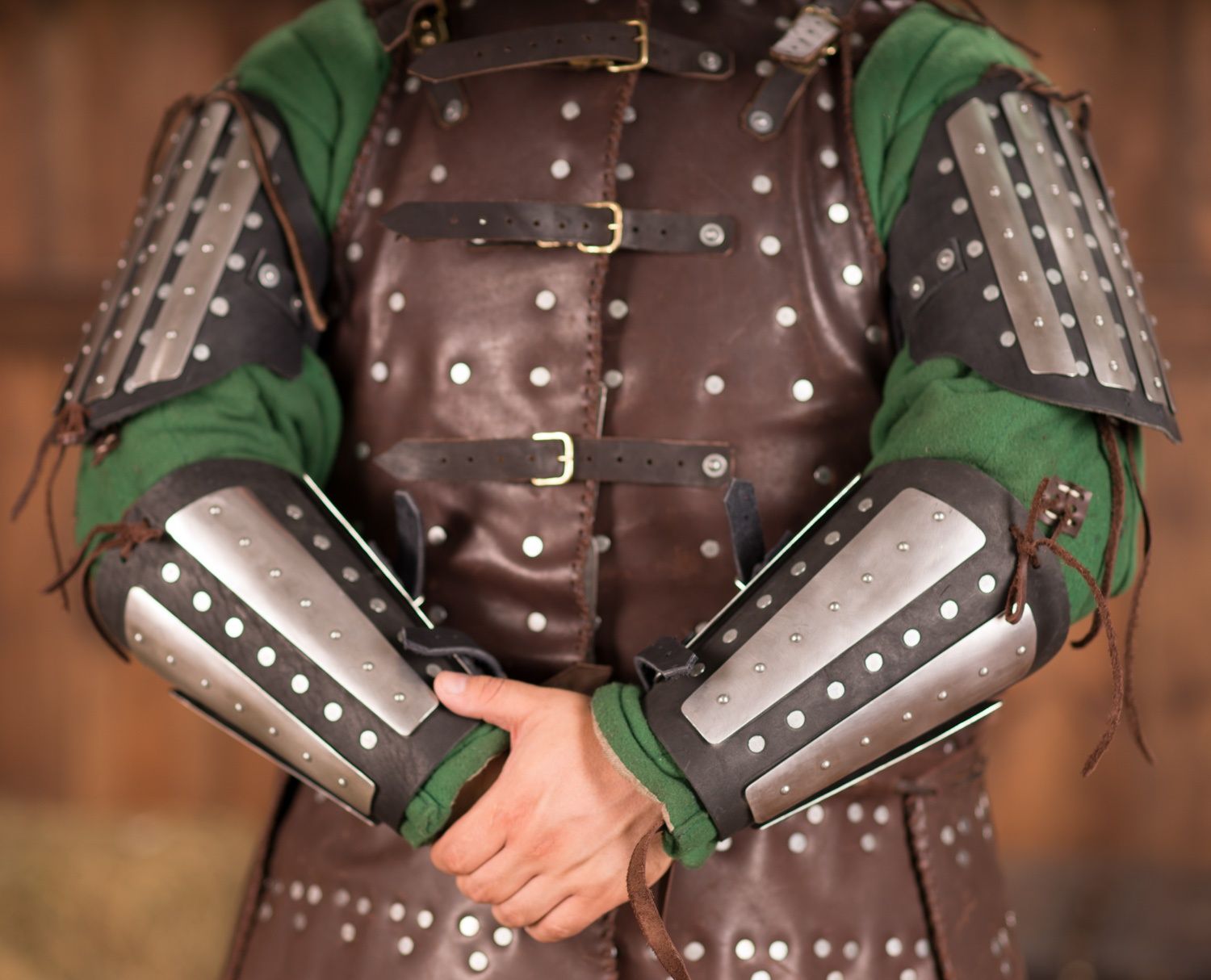
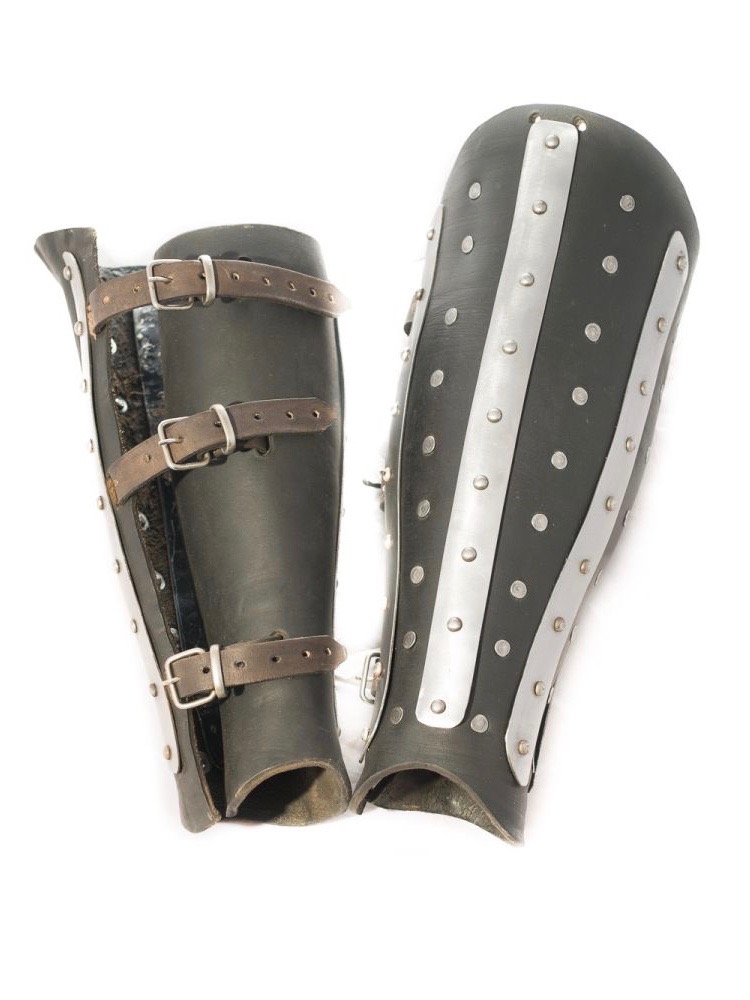
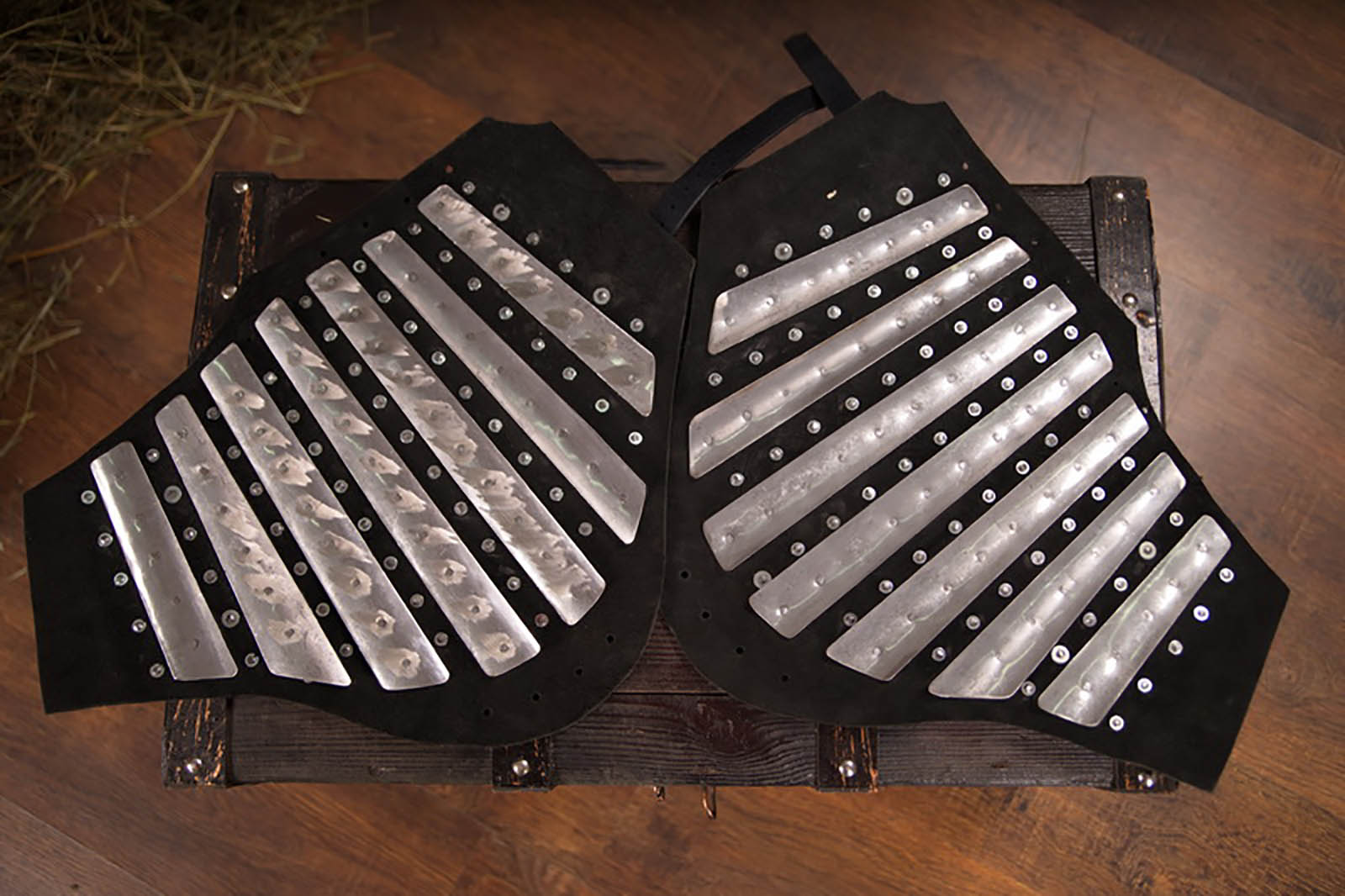
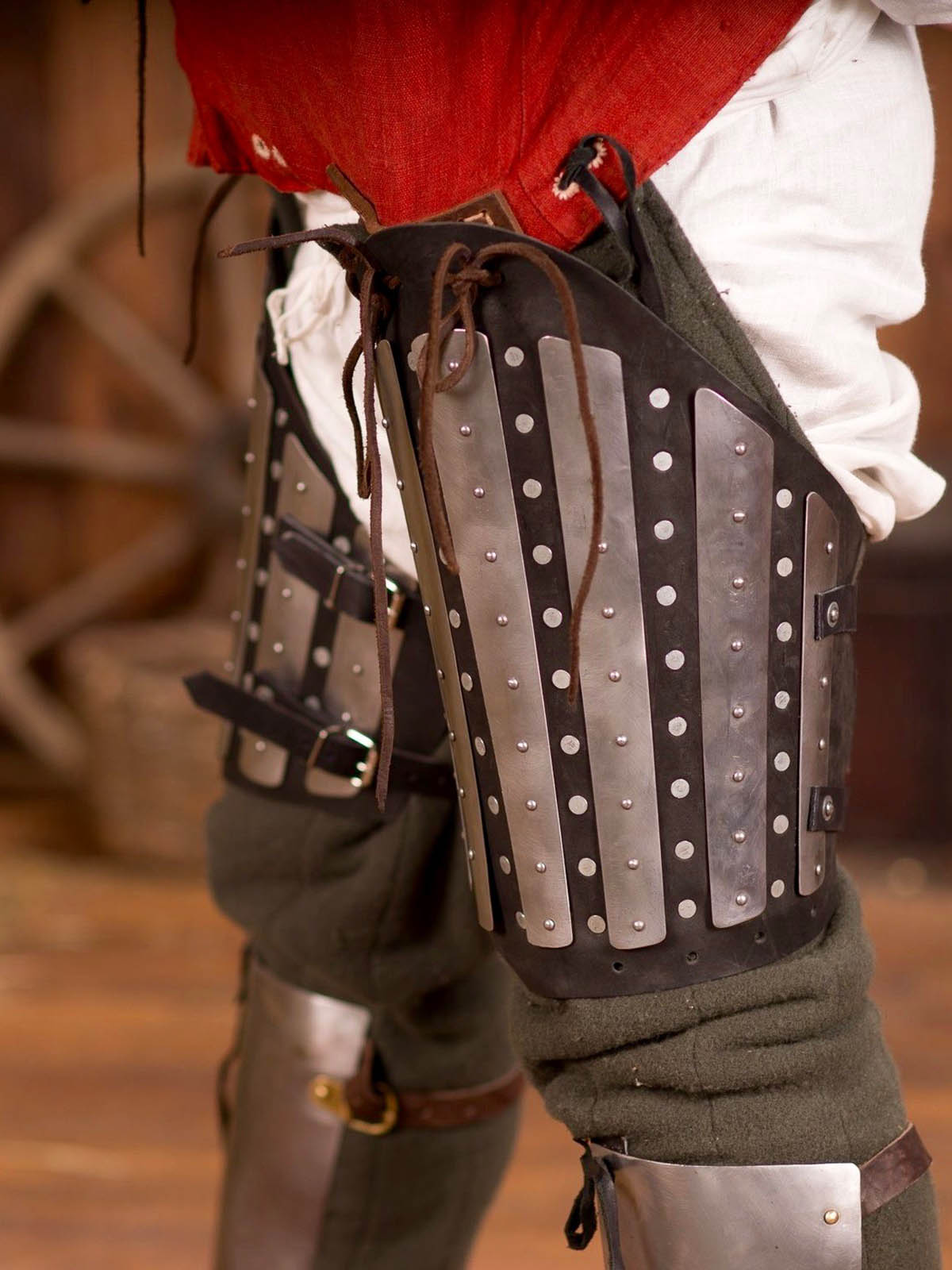
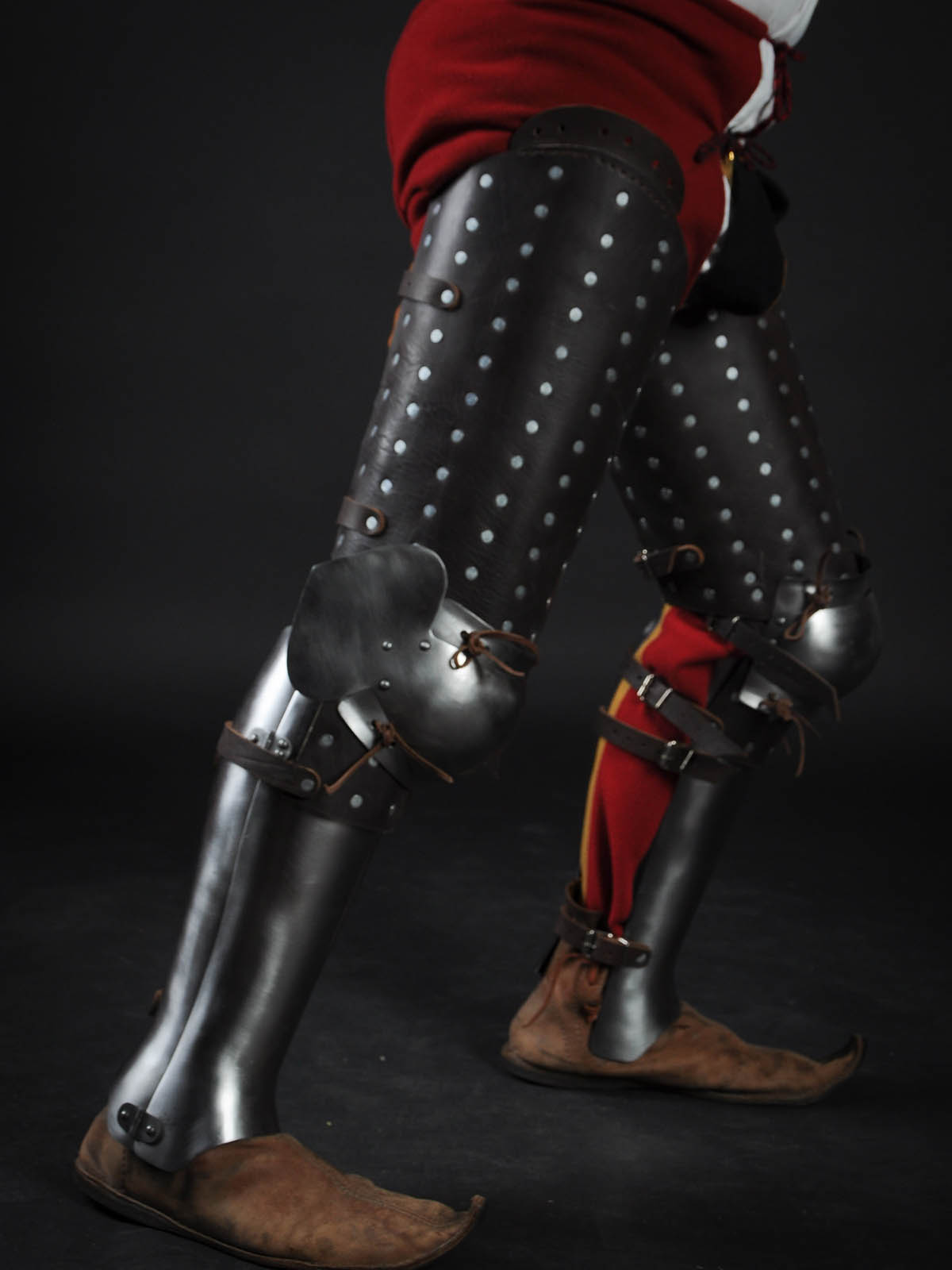
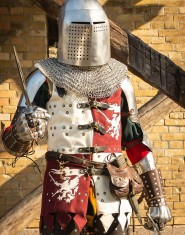
-0-1-3-185x235.jpg)
-0-1-3-185x235.jpg)
